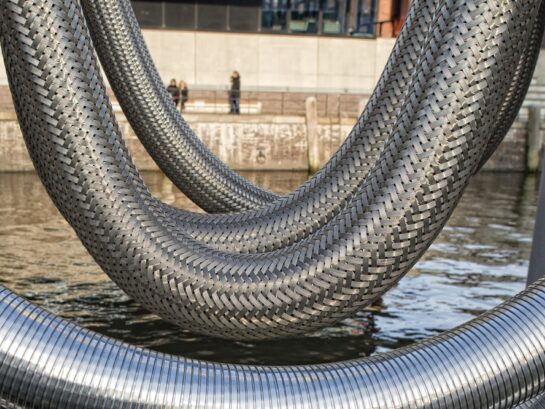Flex hoses are common components of industrial cleaning and testing systems. They conduct fluid, gas, or vapor safely from one system to another.
Choosing the right flex hose is a science in itself, as there are different types of flex hoses. It’s also important to know what areas of concern to look for before and during installation. If the cover, body, or fittings of the flex hose are damaged, it could lead to disaster once the system is turned on and the process media begins to flow through it.
In this article, we’ll help you understand flex hoses, their differences, and what to look for to determine if a flex hose is safe to use.
What Are The Types Of Flex Hoses And Their Differences?
Flex hoses come in two basic varieties: nonmetallic and metallic.
Nonmetallic Hose
A nonmetallic hose consists of a polytetrafluoroethylene (or some other flexible elastomeric material) pressure carrier tube. The tube is reinforced by fabric or wire braiding, with metal end fittings that are attached by mechanical means such as swaging or crimping.
An elastomeric material is simply a material that has rubber-like properties and is somewhat elastic. This allows it to flex without losing its shape. It also comes with a high tear resistance, which is ideal for flex hoses since it ensures that the hose won’t come apart easily.
Finally, elastomeric materials are highly resistant to water and corrosion - two qualities that you want to see in a hose, particularly if fluid passes through it.
Metallic Hose
A metal hose consists of a flexible metal pressure carrier tube surrounded by an outer layer of wire braid (some low pressure metal hoses don’t utilize an outer layer of wire braid). The flexible metal pressure carrier tube and the wire braid are attached to the hose end fittings by welding, silver soldering, or brazing.
Some metal hoses used for cryogenic applications are constructed with an inner and outer flexible metal tube, with a vacuum in the space between.
Which One Should You Use?
The nature of the application will determine whether you need a nonmetallic or metallic flex hose. For example, if the application involves extreme temperatures or aggressive chemicals, a metal hose will generally hold up better than any other kind. An expert in this field, like Precision Fabricating & Cleaning (PFC), will be able to recommend the appropriate type.
Areas Of Concern When Using Flex Hoses
Whenever you’re planning to use flex hoses, there are three main areas of concern that you should be aware of and that a cleaning and testing company will look for before the installation process. These three areas are pressure rating, inspection, and restraint.
Pressure Rating
PFC looks at the pressure ratings of flex hoses to ensure that they will stand up to the rigorous pressures demanded by the application.
There are three types of pressure ratings that must be checked.
- Maximum Working Pressure: Also referred to as “maximum allowable working pressure” or “MAWP,” this rating indicates the maximum operating pressure to which the hose should be subjected.
- Maximum Proof (Hydrostat) Pressure: This rating is the maximum test pressure to which the hose should be subjected. It is established at 150% of the Maximum Working Pressure with the hose installed straight.
- Nominal Design Burst Pressure: This is the pressure at which the hose can be expected to rupture, based on the minimum annealed ultimate tensile strength of the braid wire and corrugated hose alloys at 70˚ F with the hose installed straight.
Inspection
Next, the flex hoses must undergo an inspection. In general, the inspection involves the following steps:
- Visually inspect sealing surfaces for damage.
- Manually check mechanical connections for freedom of movement.
- Visually inspect the entire outer surface for damaged fittings, kinks, broken braid, flattened areas, soft spots, cover cracks, or other areas of degradation.
Inspecting the flex hose is extremely important. Performing this step allows the inspector to discover defects or damage that could impair the hose’s ability to function properly. Finding these problem areas also helps protect the humans who work near the flex hose from getting hurt, as it preempts a potential tear or rupture from occurring.
During our inspection, PFC will look for defects such as kinks or flat areas in the hose, damage to the hose cover, and cover blisters. Cover blisters can rupture over time as they are exposed to environmental factors, such as heat and pressure, thus creating a leak.
Below are some of the other conditions we inspect for.
- Damaged Fittings: This includes any damage to the fittings that could prevent it from operating as intended (threads damaged, swivel does not work, excessive corrosion, etc.)
- Stiffness or Hardness of the Hose: As a hose ages and is exposed to sunlight, ozone, extreme temperatures, or chemicals, it can lose some of its resiliency and become stiff and hard. When flexed, a stiffened hose can crack, leading to a catastrophic failure. To check for stiffness, we flex the hose throughout its entire length.
- Changes in Color: Changes in the color of the hose may indicate chemical attack. They could also be the result of ozone exposure or simply age. We examine the entire hose length for any evidence of changes in color.
Restraint
Finally, flex hoses that are over 2 ft in length and pressurized at 150 psi or higher must be restrained at either end with an approved restraining device. They shouldn’t just be wrapped around a pipe or tied into a knot.
This is an area where hiring an expert comes in particularly handy, as they will know the proper method for securing the flex hose.
PFC Inspects All Flex Hoses During Cleaning and Testing Services
To ensure that your flex hose is free of damage or defects, fully functional, and safely restrained, it’s wise to hire an expert like PFC.

